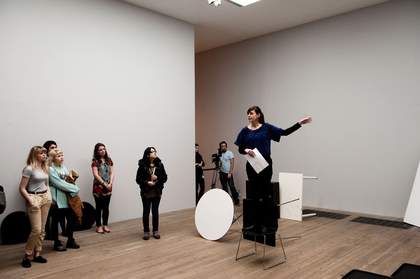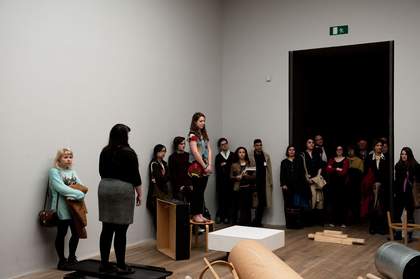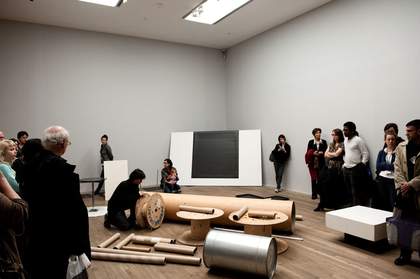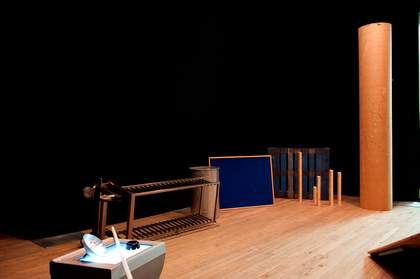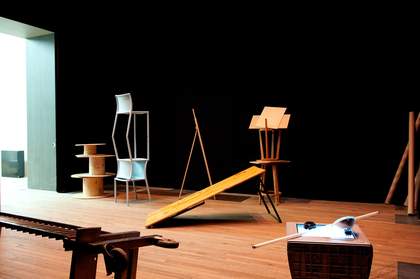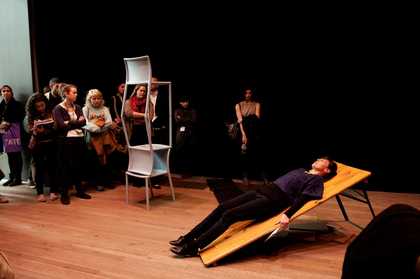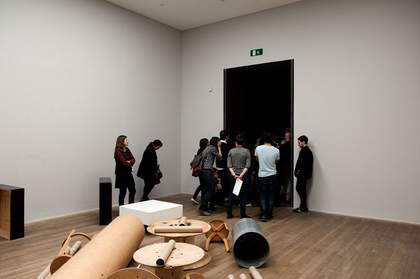Future Exhibitions was a live event by artist Sarah Pierce, included in Tate Modern Live: Push and Pull (18–19 March 2011). Pierce utilised two adjoining, empty galleries on the fourth floor of Tate Modern. She used one of the galleries as found – with bare white walls and bright lights – while in the other she draped the walls with black fabric and placed brown, turquoise and violet gels over the lights to darken them. The first echoed the iconic white cube characteristic of mid-twentieth-century galleries; the second, the more intimate space of the black box usually associated with moving image work. Both evoked spaces for the display of art, which developed in response to changes in artistic practice.
Each room was filled with assorted props. Mostly these were objects associated with art galleries or their administrative offices, including lamps, chairs, plinths and television screens. As the audience arrived, Pierce began the performance by reading a succession of five monologues, each detailing a scenario involving an historical exhibition or other gallery event from global art history. These scripts were based on documents – such as catalogues, photographs and letters – linked to the historical acts of curation and exhibition occurring within those institutions.
After each monologue, Pierce would stop and the other performers – Violet Bennell, Ka Man Ip, Annabelle Sutherland and Chloe Wade – rearranged the furniture according to her verbal instructions. In this way the group created a new quasi-sculptural setting for the next monologue.
Tate Modern Live: Push and Pull was based around Allan Kaprow’s performance environment Push and Pull: A Furniture Comedy for Hans Hoffman 1963. For this piece, Kaprow installed furniture in two rooms and allowed the public to rearrange it according to a set of instructions he had issued. Future Exhibition was a direct response to the material and form of Kaprow’s original work, but Pierce redirected Kaprow’s instructions towards remaking other historically significant exhibitions. The title Push and Pull repurposed a phrase from the painter Hans Hoffman, who was also Kaprow’s teacher, describing how an artist could create movement in a painting. Kaprow’s use of the phrase in his expanded art practice concerned transformation, specifically moving an idea from its application in one artistic medium – painting – to another – action. Pierce’s event built on Kaprow’s work, but instead used the performance to explore the movement of ideas in exhibitions and curation.
By using documents from historical exhibitions as a basis, coupled with the visuals of Kaprow’s installation, Pierce explored how members of an institution collaborate to bring a work of art into being through certain framing devices. Rather than showing other artists’ works, Pierce created sculptural ensembles from the institutional furniture, exploring the role of the museum and curation in defining art. The unrehearsed actions of moving the furniture, guided by Pierce’s performance as the curator, resulted in a new sculpture. In this way, each act of curation provoked a new interpretation of the material and a new vision of what that artwork could be.
In addition to exploring the action of curating and exhibition-making, the piece evoked the idea of memory, through the re-performance of archival documents and particularly individual memories of artworks and exhibitions. The title of the piece, Future Exhibitions, also looked forward suggesting both how new exhibitions draw on older precedents, but also how they change and revise them. By enlivening historic documents through action in the present, under a title focused on the future, Pierce brought together various acts of curation into a narrative of creative practice.
Acatia Finbow
October 2015

